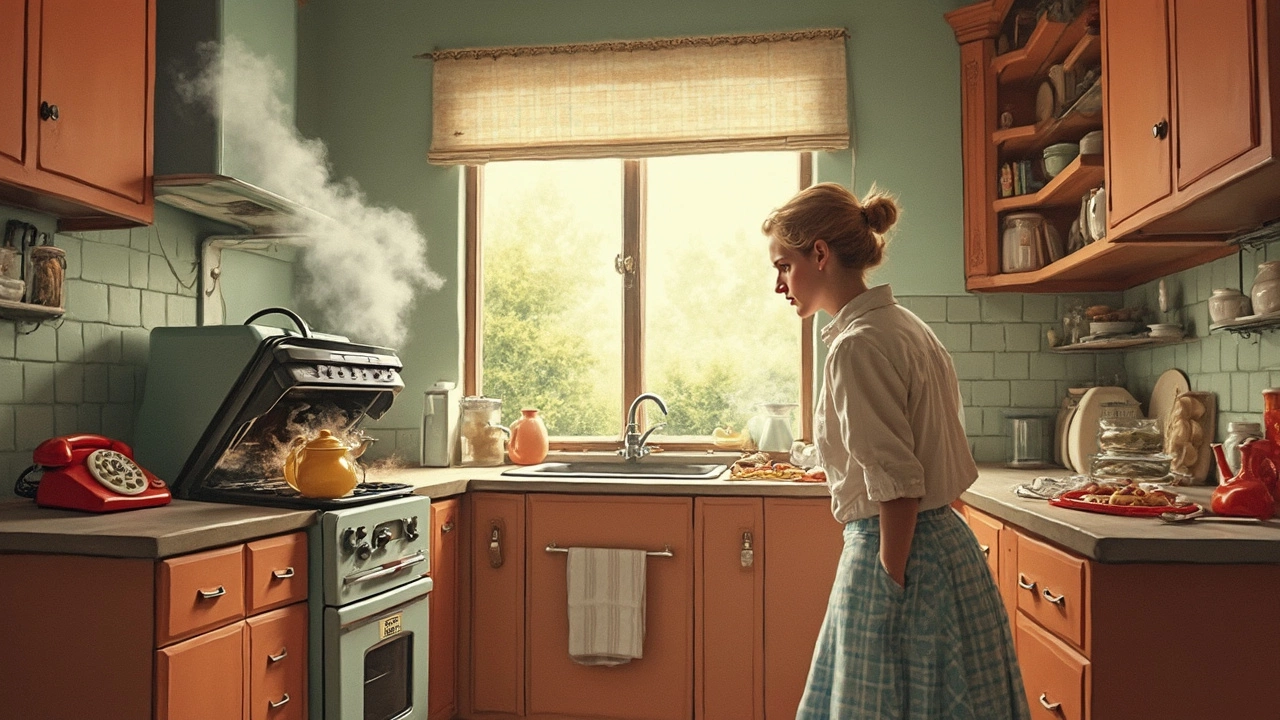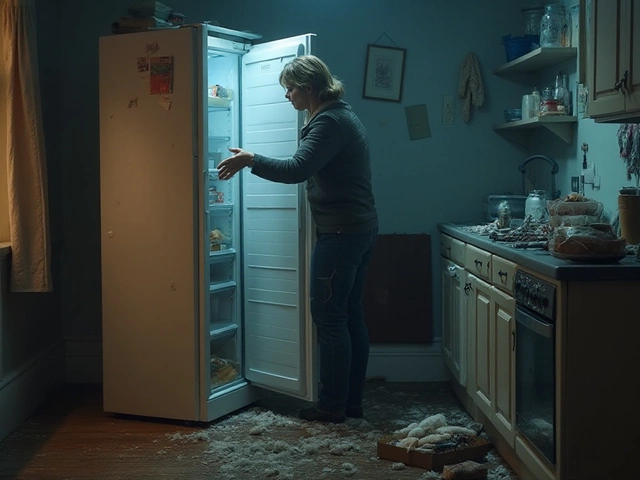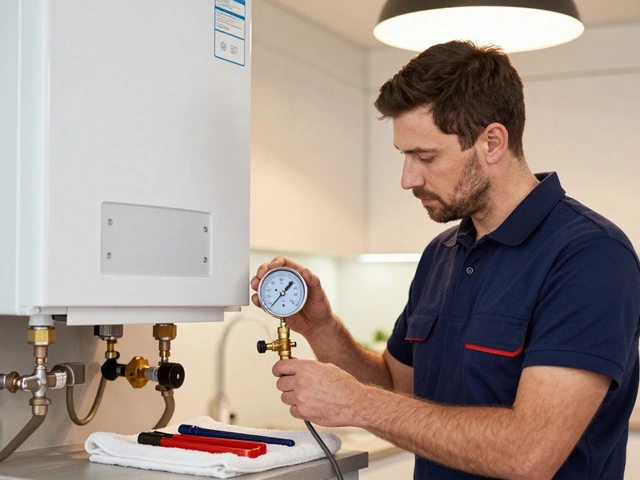Ever popped a casserole in your electric oven only to find it half-baked an hour later? Frustrating, right? Before you toss out perfectly good kitchen equipment, let's see if we can solve these oven mysteries. You're not alone; many folks face the quirky and sometimes annoying tendencies of electric ovens.
First off, weird noises could be trying to tell you something. It might be the fan rattling or elements giving a death cry. Noticing this earlier could prevent a full-blown meltdown later. Speaking of heating, if your pizza's sliding out soggy in the middle, chances are your oven has a heating issue. Often, this means a faulty thermostat or element needing some attention.
Then, there's the electrical side of things. Tripping circuits or flickering oven lights often signal deeper electrical problems. While some of these can be DIY fixes, others might need a pro's touch. Knowing when to throw in the towel and call someone can save you from bigger headaches down the road.
- Common Signs of Trouble
- Understanding Heating Problems
- Strange Noises and Their Causes
- Dealing with Electrical Issues
- When to Call a Pro
Common Signs of Trouble
Catching issues with your electric oven early can save you both time and money in the long run. Here are some telltale signs that your oven might be heading for a breakdown. We’ll break it down so you can spot these problems with ease.
Uneven Cooking
If your dinners look more like culinary experiments gone wrong, where one side is crispier than the other, your oven might have an uneven heating problem. Usually, this is due to a faulty heating element or a bad thermostat. Check if your oven's heating elements are glowing evenly when in use—if not, it might be time to replace them.
Strange Noises
Bumps and thuds coming from your oven? No, it's not haunted—probably just a loose fan or worn motor bearings. These noises can get worse over time if ignored and might even lead to more serious damage.
Failure to Heat
Nothing's more frustrating than putting a meal in the oven only to have it come out cold. If your oven isn't heating up at all, the culprit is often a burned-out heating element or a broken connection in the wiring.
Inconsistent Temperature
Finding that your cookies are either underdone or over-browned? The temperature might not be holding steady. Often this is due to a malfunctioning thermostat or sensor. Knowing how to manually check and calibrate your oven's temperature can help keep that from happening.
Frequent Tripping of Circuit Breakers
If turning on your oven feels like playing roulette with your home's electrical system, it might be drawing too much power or have a short circuit. This is not just a nuisance but a potential fire hazard, so addressing it promptly is crucial.
| Common Issue | Possible Cause | Solution |
|---|---|---|
| Uneven Cooking | Faulty Heating Element | Replace Heating Element |
| Strange Noises | Loose Fan | Tighten Components |
| No Heat | Burned-out Element | Repair/Replace Element |
| Inconsistent Temp | Broken Thermostat | Calibrate/Replace Thermostat |
| Tripping Breakers | Electrical Short | Call an Electrician |
By keeping an eye out for these signs and acting promptly, you can extend the life of your oven while ensuring it's always ready for your next cooking adventure.
Understanding Heating Problems
Alright, let’s get to the nitty-gritty of why your electric oven might not be heating properly. One of the most common culprits is a faulty thermostat. Think of it like the brain of your oven—it tells the rest of the appliance how hot to get. If it's malfunctioning, that lasagna might end up toast, while your bread stays doughy.
The Role of Heating Elements
Next up, let's talk about heating elements. These are the parts that actually get hot and cook your food. If they’re broken or worn out, you might notice uneven heating or even cold spots. To check, look for visible signs like blisters or breaks in the element. And don't go poking around unless the oven's unplugged—safety first!
Simple Checks You Can Do
Before you panic, try this: ensure that your oven is set to the right cooking mode. Sounds basic, but it can save you a headache. Explore the dials and options; sometimes it’s the little knobs that make the difference.
- Check the temperature settings and make sure they're accurate with an oven thermometer.
- Inspect the power source by checking the circuit breaker or fuse box.
- Look at the oven door seal—any gaps could let out the heat and mess with the cooking.
Advanced Troubleshooting
If those basic tweaks don’t cut it, the issue might be with the temperature sensor that works with the thermostat. When it’s off kilter, it might feed wrong info to the oven’s brain.
| Component | Problem | Solution |
|---|---|---|
| Thermostat | Inaccurate readings | Replacement might be necessary |
| Heating Element | Not glowing | Visual check and replace |
| Temperature Sensor | Incorrect signals | Calibration or replace |
Remember, messing around with electrical stuff isn’t for everyone. If in doubt, tapping into the expertise of a professional can be a real lifesaver.

Strange Noises and Their Causes
No one enjoys a noisy kitchen, especially when the racket comes from your trusty electric oven. If your oven's been sounding like a mini construction site, it's time to figure out what's going on.
Rattling Sounds
If your oven is rattling, the culprit is often a loose part. The fan can work its way free over time, especially with heavy usage. Simply tightening the fan screws can solve this. However, if the noise persists, the fan motor might need a replacement.
Buzzing or Humming
A constant buzz usually points to an electrical issue. This could be a malfunctioning relay switch. Swapping out these parts usually requires a bit of electrical know-how, so unless you're savvy with a screwdriver and caution tape, you might want to call for help.
Squeaks and Squeals
Annoying squeaky sounds often arise from the oven door hinges. Lubricating them with high-temperature grease can silence that embarrassing serenade every time you open the oven.
To give you a better overview, here's a quick guide to what these sounds might mean:
| Sound | Possible Cause | Solution |
|---|---|---|
| Rattling | Loose Fan | Tighten screws or replace motor |
| Buzzing | Relay Switch Issue | Check or replace relay |
| Squeaking | Dry Hinges | Apply high-temp grease |
Handling these common noises not only saves your sanity but also extends the life of your electric oven. Always remember, if you're not comfortable handling electric parts, there's no shame in reaching out for professional help.
Dealing with Electrical Issues
When your electric oven decides to glitch out, it can feel like you're stuck in the dark ages. But hey, don't panic yet. Electrical issues are pretty common and often easier to fix than you might think. It starts with identifying the signs, like tripping breakers or non-responsive controls. These are your oven's way of waving a tiny white flag.
Breaker Tripping Troubles
If your oven's causing circuits to trip, it's time to check for faulty wiring or even a malfunctioning heating element. Start by inspecting the cord and plug for obvious damage. Look out for burnt marks or frayed wires, which could mean it's time for a replacement. If everything seems in order, the element itself might be to blame.
Control Panel Woes
A wonky control panel is a different beast. If buttons aren't responding, the circuit board could be fried. Sometimes, a simple reset does the trick: unplug the oven, wait a minute, and plug it back in. No luck? You might need to replace the panel. Make sure you match the model number when ordering a new one.
The Importance of Professional Help
It's tempting to go all DIY on electric issues, but sometimes calling a pro is the smarter move. Especially if you're not comfortable around wires or simply can't pinpoint the problem. A professional can safely diagnose and fix complex issues, ensuring your oven is back to its culinary magic in no time.
Safety First
When dealing with electrical bits, always, always, put safety first. Turn off the oven's power at the breaker before getting your hands dirty. Wear rubber gloves if you're poking around wires. Electricity can be dangerous, folks, so no heroics here—better safe than sorry.

When to Call a Pro
Alright, so you've done your bit of troubleshooting, and things aren't looking up. When's the right time to call in the cavalry, aka the professionals? Let's break it down.
Beyond DIY Fixes
If swapping out a faulty element didn't solve the problem or you're dealing with more than just a popped circuit, it's time to consider calling a professional oven repair service. Messing with the electrical components without the right skills can be risky business. If you've noticed your electric oven sparking or producing a burnt smell, that's a big red flag. Leave it to the experts.
Common Issues Requiring a Pro
- Burner Malfunctions: When burners refuse to heat or heat unevenly, you might be dealing with a malfunction beyond a simple DIY repair.
- Faulty Wiring: If the wiring is framed, outdated, or appears damaged, only a certified technician should handle it.
- Thermostat Issues: If calibrating the thermostat doesn't fix the temperature swings, a replacement might be necessary and requires expert handling.
Professionals have access to specialized tools and replacement parts. They know how to diagnose issues efficiently and minimize the risk of further damage to your precious appliance.
Trusted Services
So how do you find the right service? Check reviews, ask neighbors, or search online for local repair shops boasting great feedback. You'll sleep easier knowing someone with the know-how is handling your oven repair.
Gauging Costs
It's also wise to consider the cost factor. Repairing an older model might not be worth it, especially if parts are scarce or expensive. Weigh repair costs against buying a new oven. Sometimes, retirement is the kindest option for your hardworking appliance.
Remember, safety first. Don't sweat the small stuff, but know when to call in the pros to keep your kitchen running smoothly.







